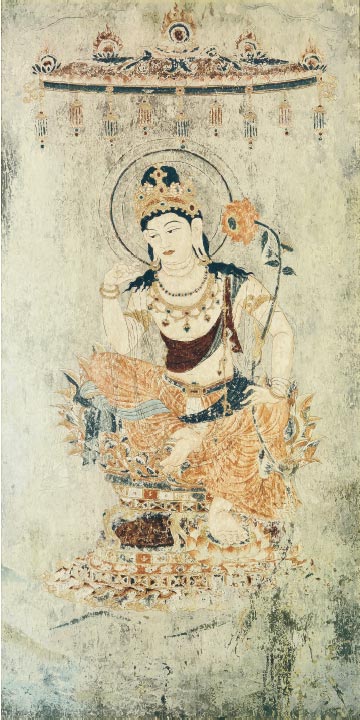

Woven with new elements, Lotus Miroku is beautifully rendered with expressions and
techniques unique to tapestry. While spectacularly reproducing the
deity from the wall painting with 6000 color threads, the tapestry
faithfully reproduces the changes sustained over a period of more
than one thousand years by the mural paintings, such as color damage
and wall stains. This bodhisattva tapestry, entitled Lotus Miroku,
reminds us of the long period of time that this deity has been in
deep meditation for the liberation of all living beings.
Although the museum planned this exhibition in order to present these two tapestries together for the first time, the main theme is not tapestry or textiles. The first half of the show features Willow Kannon, who appears in Hibo Kannon as a compassionate mother, and perspectives on how Kano Hōgai came to create this unique painting. Here, we see how Hōgai took the image of a bodhisattva holding a willow branch and a water vase, which comes from a widespread ancient belief in the willow and sacred water combined with a Buddhist deity, to symbolize the birth of humanity. The second half of the exhibition examines the contemplative form of the bodhisattva sitting with one leg pendant, which was introduced to Japan from India via China and the Korean peninsula and how this image captured people’s hearts far and wide from its creation in India before Shakyamuni Buddha achieved enlightenment to its manifestation in Kannon, and its reception in Miroku. While looking back on the spirit that went into this form, the heart of Lotus Miroku from the main hall of Hōryū-ji Temple revived through the tapestry is explored.
Although the museum planned this exhibition in order to present these two tapestries together for the first time, the main theme is not tapestry or textiles. The first half of the show features Willow Kannon, who appears in Hibo Kannon as a compassionate mother, and perspectives on how Kano Hōgai came to create this unique painting. Here, we see how Hōgai took the image of a bodhisattva holding a willow branch and a water vase, which comes from a widespread ancient belief in the willow and sacred water combined with a Buddhist deity, to symbolize the birth of humanity. The second half of the exhibition examines the contemplative form of the bodhisattva sitting with one leg pendant, which was introduced to Japan from India via China and the Korean peninsula and how this image captured people’s hearts far and wide from its creation in India before Shakyamuni Buddha achieved enlightenment to its manifestation in Kannon, and its reception in Miroku. While looking back on the spirit that went into this form, the heart of Lotus Miroku from the main hall of Hōryū-ji Temple revived through the tapestry is explored.